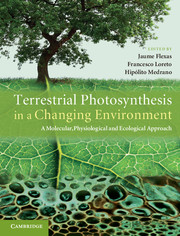 Terrestrial Photosynthesis in a Changing Environment
Terrestrial Photosynthesis in a Changing Environment Book contents
- Frontmatter
- Contents
- List of contributors
- Preface
- Acknowledgements
- List of abbreviations
- 1 Terrestrial photosynthesis in a changing environment
- Part I Photosynthesis
- Part II Measuring photosynthesis
- 9 Gas-exchange analysis: basics and problems
- 10 Optical methods for investigation of leaf photosynthesis
- 11 Stable isotopic compositions related to photosynthesis, photorespiration and respiration
- 12 Mesophyll conductance to CO2
- 13 Biochemical and molecular techniques for the study of photosynthetic processes
- 14 Measuring CO2 exchange at canopy scale: the eddy covariance technique
- 15 Remote sensing of photosynthesis
- Part III Photosynthetic response to single environmental factors
- Part IV Photosynthesis in time
- Part V Photosynthesis in space
- Part VI Photosynthesis in a global context
- References
- Index
15 - Remote sensing of photosynthesis
Published online by Cambridge University Press: 05 March 2013
- Frontmatter
- Contents
- List of contributors
- Preface
- Acknowledgements
- List of abbreviations
- 1 Terrestrial photosynthesis in a changing environment
- Part I Photosynthesis
- Part II Measuring photosynthesis
- 9 Gas-exchange analysis: basics and problems
- 10 Optical methods for investigation of leaf photosynthesis
- 11 Stable isotopic compositions related to photosynthesis, photorespiration and respiration
- 12 Mesophyll conductance to CO2
- 13 Biochemical and molecular techniques for the study of photosynthetic processes
- 14 Measuring CO2 exchange at canopy scale: the eddy covariance technique
- 15 Remote sensing of photosynthesis
- Part III Photosynthetic response to single environmental factors
- Part IV Photosynthesis in time
- Part V Photosynthesis in space
- Part VI Photosynthesis in a global context
- References
- Index
Summary
Introduction
Remote sensing of photosynthesis consists of directly measuring or indirectly estimating photosynthesis rates or photosynthesis-related parameters using non-contact devices positioned far from the plant or canopy. This definition is a broad one, and includes the gas-exchange measurements at the ecosystem level described in Chapter 14, but the term is more commonly used to describe radiation measurements with spectrometric techniques. Three main groups of spectrometric techniques have emerged to remotely assess photosynthesis or photosynthesis-related parameters: reflectance, fluorescence and thermal imagery (Fig. 15.1). Each of these principles has advantages and inconveniences as compared with the others. These are summarised in Table 15.1, and will be discussed in more detail throughout the chapter.
Remote sensing has been identified as an essential tool to complement gas-exchange and atmospheric-circulation models, in order to monitor accurately the spatial and temporal changes in biosphere primary production (Sellers et al., 1992, 1997; Baldocchi, 2008; Malenovsky et al., 2009). Although there have been important advances in this field during the past thirty years, a comprehensive review of the techniques available and their scope is lacking. Partial reviews on remote sensing of reflectance (Peñuelas and Filella, 1998; Gamon and Qiu, 1999), fluorescence (Cerovic et al., 1999 ; Moya and Cerovic, 2004) and thermometry (Jones, 1999 , 2004a) have been published. However, none of these reviews includes recent advances, and none has treated all these techniques together. An early review by Lichtenthaler et al. (1998) considered reflectance and fluorescence, and these two techniques have been recently evaluated together with the focus of their potential for measuring terrestrial photosynthesis from space (Grace et al., 2007 ). Chaerle et al. ( 2007a ) have reviewed the usefulness of combined thermal and Chl-F imaging for monitoring and screening plant populations. All three types of techniques were considered together in a review by Cifre et al. (2005), but these authors focused only on their specific use in irrigation scheduling in grapevines. Meroni et al. (2009) have reviewed remote sensing of solar-induced Chl-F, whereas several recent reviews have focused on light-use efficiency and PRI (Coops et al., 2010; Hilker et al., 2010; Garbulsky et al., 2011). Only a recent review has considered together the scientific and technical challenges in remote sensing of both plant reflectance and fluorescence (Malenovsky et al., 2009).
- Type
- Chapter
- Information
- Terrestrial Photosynthesis in a Changing EnvironmentA Molecular, Physiological, and Ecological Approach, pp. 219 - 236Publisher: Cambridge University PressPrint publication year: 2012
- 5
- Cited by
